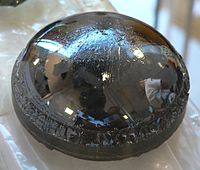
Photo from wikipedia
DOI: 10.1002/aelm.201700608 gap structure cannot be able to integrate in vertical direction. In 2008, Salahuddin et al.[8] proposed negative capacitance transistor using the polarization change induced abrupt switch with steep… Click to show full abstract
DOI: 10.1002/aelm.201700608 gap structure cannot be able to integrate in vertical direction. In 2008, Salahuddin et al.[8] proposed negative capacitance transistor using the polarization change induced abrupt switch with steep slope (Figure 1b). But at present, the integration of the ferroelectric materials with smaller hysteresis window is remained to be studied. A critical question that can be considered is if there is another mechanism that can be applied to build novel transistor with steep slope. Here, we propose a new kind of steep slope transistor named “filament transistor” with SS down to sub-10 mV dec−1. The abrupt filament set/reset induced by gate can enable the abrupt current change with steep slope. Conventional resistive random-access memory (RRAM) is usually a simply two-terminal device with a metal oxide layer sandwiched by two metal electrodes. Due to the high-carrier densities (above 1020 cm−3) of metal electrode, the gate E-field is screened by the bottom electrode without any gate tunability. In this work, the bilayer grapheme (BLG) is used as bottom electrode with low-carrier densities[20] (around 1012 cm−2) connecting to the source terminal, which can let the gate E-field effective penetrate through the graphene. The channel material above graphene is AlOx with 5 nm thickness in vertical direction, so that the gate E-field can effectively control the filament formation/rupture inside the AlOx. The top electrode Al above the AlOx is connected to drain terminal. The schematic device structure and operation mechanism for the filament transistor at on-state and off-state are shown in Figure 1c. At positive gate voltage condition, the positive E-field from gate can attract oxygen ions moving toward the bottom surface. In this case, the effective oxygen ions density is low, which is named as the “oxygen ions depleted” state. As a result, it requires higher set voltage at drain terminal. When negative gate voltage is applied, the negative E-filed from gate can repel the oxygen ions to top electrode, which is named as “oxygen ions accumulated” state. The “oxygen ions accumulated” state can promote the filament formation, which means a lower set voltage at drain terminal can be sufficient for the filament formation. The device was fabricated as following: the single crystal bilayer graphene was obtained via chemical vapor deposition (CVD) method or mechanical exfoliation. For CVD method, first one single-layer graphene (SLG) with ≈50 μm size was grown and then through the center defect, another SLG was grown followed by oxygen patterning. The BLG was transferred/exfoliated to a SiO2 (300 nm)/Si substrate with a marker. This was There is a growing trend of developing steep slope transistors with subthreshold swing (SS) below 60 mV dec−1. At present, there are mainly three kinds of steep slope transistors: tunneling transistor, negative capacitance transistor, and nano-electromechanical relay. Here, a new kind of steep slope transistor named “filament transistor” is proposed with SS down to sub-10 mV dec−1. Due to the gate E-filed can penetrate through the graphene, the gate can effectively control the filament formation/rupture inside the 5 nm AlOx with very steep slope. In reverse sweep, the gate can induce the filament formation with SS down to 4.6 mV dec−1. In forward sweep, the gate can break the filament with SS down to 12.2 mV dec−1. Taking the advantages of nanofilament, the filament transistor holds a great potential to scaling down to 5 nm without performance changing.
Journal Title: Advanced electronic materials
Year Published: 2018
Link to full text (if available)
Share on Social Media: Sign Up to like & get
recommendations!